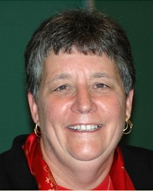Homily, Janet Kalven’s Memorial Service
Homily by Mary E. Hunt
At Janet Kalven’s Memorial Service
 June 1, 2014 | Grailville, Loveland, Ohio
June 1, 2014 | Grailville, Loveland, Ohio
Originally posted for Feminist Studies in Religion
How fitting that we gather here at Grailville, the center that Janet Kalven helped to found, in this lovely barn turned Oratory on the land that Janet Kalven loved. As was evident in the “Circle of Remembrance,” we come not to mourn a tragedy, but to rejoice in the goodness of a life well lived. It is a life that each of us had the luck to touch whether we were Janet’s relative, friend, neighbor from Loveland or Northside, Grail companion, and/or colleague. So it is Janet who brings us together today, perhaps modest proof, even to those of us who are doubtful, that there is some life after death.
I met Janet here at Grailville in the summer of 1975, when I arrived for the Seminary Quarter program that she and a committee had crafted so creatively. I returned the next year, with Janet’s encouragement, to work on the summer team in the garden and in the kitchen, all the while hanging around that year’s Seminary Quarter to imbibe its richness. We became friends, working together on projects and publications, visiting the Grail in the Netherlands, and spending time with my family.
When I met Janet in 1975, she was the age I am now. That means that everything I experienced with her happened in her life after she turned sixty, not to mention all that went before. This helps me to affirm, as she did so often, Robert Browning’s verse,
“Grow old along with me!
The best is yet to be,
The last of life, for which the first was made:”
(“Rabbi Ben Ezra,” in Dramatis Personae, 28 May 1864)
Few people live the last forty years of their lives with the same verve with which they lived, may I say in this case, the first sixty! Janet did just that, taking out her first mortgage on a rehabbed sixth grade classroom at age 93, and enjoying a Cincinnati Reds baseball game at age 100 thanks to her devoted friend Maureen Wood.
Janet’s friend Marian April Goering has captured the essence of Janet’s life in a wonderful biographical essay that is on the Grailville website (http://www.grailville.org/news/grailville-says-goodbye-to-one-its-founding-members/ ). We all know the general outline: smart young Jewish woman from Chicago studies the “Great Books,” converts to pre-conciliar Catholicism, joins the Grail, changes the world. Janet told the story herself in a vivid memoir, Women Breaking Boundaries: A Grail Journey, 1940-1995, which I highly recommend for its rich detail and elegant writing.
Janet’s book is a first person account of the Grail in the United States, from the time Lydwine van Kersbergen and Joan Overboss arrived from The Netherlands in 1940, until the recent ecological wetlands project at Grailville. Janet was always quick to suggest teamwork, to find a partner to work on a project, to affirm that great Grail saying, “Together, we’re a genius.” But to my knowledge, no one else took on the task of detailing the Grail movement’s development interwoven with a Grail member’s own story. In so doing, she chronicled the concrete ways that women create new spaces beyond the many and varied boundaries they have to break in order to survive with integrity. For this, we are in Janet’s debt.
I predict that there will be doctoral dissertations on her life. Attention: members of the Grail Archives Committee! Get those papers to the archives! She will be studied because she lived and worked and wrote over the twentieth century with perspectives and commitments that many progressive people of faith share. Her story, while singular, is also the story of this place, this movement called the Grail, and the larger struggles of people of faith to love well and do justice in very challenging times. It is a story worth studying, a prototype of what life can be when lived in community with purpose.
Our reading today from the Book of Wisdom (7:7-14; 7:22-8:1) is well chosen on two counts: first, Janet converted to Catholicism, but over the years she grew in her appreciation of her Jewish roots, both in their religious and secular content. Hebrew Scripture, especially the Psalms, had a special place in her feminist faith. Listen again to the description of Wisdom Sophia in this scripture: “intelligent, holy, unique, manifold, subtle, mobile, clear, unpolluted, distinct, invulnerable, sure, free from anxiety…” It begins to say “Janet Kalven” to me.
Second, the Spirit of Wisdom Sophia was an important part of Janet’s feminist spirituality. After all, she hosted some of the key gatherings here at Grailville where women theologians, ministers, rabbis, and others plowed the field of feminist work in religion, transforming the religious landscape on a global scale. Though she always loved the Eucharist, which is why we celebrate it today, she grew tired of the language, images, and practices of any church that excluded women, people of color, lesbian, gay, bisexual, transgender people, and others from leadership and full participation. But she did not turn her back on the Catholic Church, much less the Christian community. Rather, she rolled up her sleeves, as she did in the garden among her herbs, to create new spiritual options, including what is known as women-church.
In a paper about the women-church movement of which she was a stalwart member, Janet wrote: “…we did not mean a church of women only. Rather, we were naming women as equal members of the Christian community, able to take leadership in the light of their experience and insights. While the idea of Women-Church has been put forth by Catholic women, it has drawn strong response from women of other traditions. The movement is ecumenical and inter-faith.” (Janet Kalven, “Women-Church As It Is For Me,” undated, approximately 1995).
Such movements, like the Grail, require a firm spiritual foundation or they can devolve into cults or political cells, or simply flame out. So Janet paid attention to the base of women-church. She reflected as follows: “I think of times of celebration when we felt our collective strengths, and we experienced the presence of the Spirit. I think of times of intimate revelation when women shared their stories of pain and suffering; of times of healing when we prayed with a woman whose house had been vandalized; of times of joy when we joined in the naming of a newborn or celebrated a 70th birthday; and of times of hard study when we grappled with the new ideas of the women theologians in our midst…Inspired by the Spirit, we have a new sense of our own powers, a new awareness of the sacred in our daily lives. We are nourishing each other in small gatherings and large, as we commit ourselves to speak justice, justice for women and for all who are oppressed and marginalized.” (Janet Kalven, “Women Church…”) It was that Wisdom Sophia inspired faith that kept Janet and so many of us going despite being, as she put it so succinctly in her memoir, “fast women in a slow church.”
Writing was one of Janet’s many gifts. She treasured her membership in the group “Women Writing for a Change,” insisting that it was not simply writing, but writing as a means to a social justice end that kept her at it. With the advent of computers, she reported that she sent out “Several e-mails most days against the latest policies of the Bush administration, in defense of the environment, for working families, for Medicare and a real prescription drug benefit.” (Janet Kalven, “Holiday letter to friends,” December 2003).
History will remember Janet as a teacher’s teacher. In her years at the University of Dayton where she worked in the office of Self-Directed Learning Program, and in the stellar programs that made Grailville a household word among women in religion, Janet created spaces for people to meet their own educational needs and goals. How remarkable it seemed for someone trained in the “Great Books” to be so innovative. Then again, how absolutely consistent with the “Great Books” approach was her self-directed learning model, both of which encourage questions, discussion, and discernment.
I remember many conversations with Janet about the Grail. For example, we debated whether as a “pious union” and not a religious order the Grail was canonically captive under Roman Catholic Canon Law as many Catholic women’s religious congregations have learned painfully, or, whether it was free of such ties. Janet could hold her own in any argument and she was invariably right. I understood why she missed her beloved brother Harry, a highly regarded professor of law who predeceased her by decades. I can only imagine their lively exchanges as children and as adults.
To sit next to Janet at a meeting was to listen to the quiet click of knitting needles. It was to watch the occasion scribble in her own shorthand system. It was to be amazed by her keen interventions, and to marvel at her endless, Grail-trained patience with the process.
Janet lived a graced life. But one does not live a hundred years without certain ups and downs. So, her two bouts with cancer and her slow diminishment in the last five years of her life were the down times. Nonetheless, Janet was always game and positive. She took a fall at my house in Maryland and had to go to the hospital in the middle of the night. I recall her charming the socks off of the young Emergency Room intern. He had done some training in Cincinnati. Before she finished with him, he was a new friend, and she was patched up, ready to go to her next protest. Janet was like that with people—charming and genuinely interested in their wellbeing.
Janet had the wherewithal to realize early on that she did not want and did not need to have the kind of life that women of her mother’s generation lived. She chose the Grail, not as a way to escape the confines of western, racist, upper middle class, patriarchal life. Rather, she embraced the mission of the Grail, a group “committed to spiritual search, social transformation, global solidarity, ecological sustainability, and the release of women’s creative energy throughout the world.” (http://www.grail-us.org/)
Janet embodied the Grail for scores of women—ministers who came to Grailville for respite when they were overwhelmed by the demands of their jobs; young women who took part in the Semester and Seminary Quarters at Grailville; urban pioneers who created affordable housing in Cincinnati. Likewise, the Grail upheld Janet. Sometimes, I suppose, some members wondered if she was a little ahead of her time or travelling in the company of women who were just a tad too fast (in an increasingly slower church!). But her commitment to the Grail, and the Grail’s commitment to her, were unwavering in their faithfulness.
I sense that Janet’s death closes an important chapter in the history of the U.S. Grail and Grailville, a time from its founding to this year. Her passing opens a new and unknown chapter for which her life and work may simply be a prelude. I hope and I trust that her spirit will be an inspiration for the 2014 Grail General Assembly as it deals with very important issues and decisions.
In articulating her vision, Janet wrote: “Personally, I ground my hope for the world and for the Grail chiefly in the strength of women, women who develop all of their gifts and talents, women who act together generously and in hope to bring into reality their vision of a world where difference does not connote domination, a world where each person and culture will grow and enrich the others, a world where a hope-filled future awaits every child. We hold fast to our conviction that terror, poverty, and oppression will not have the last word. We rely on God’s promise, ‘Behold, I make all things new’” (Women Breaking Boundaries, p. 303).
Strengthened by Janet’s friendship, and with her long and graced life for inspiration, we can all play our parts in making all things new. Let her memory be our blessing.


